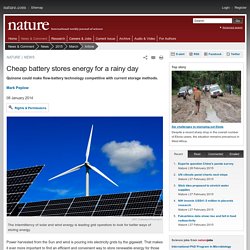

So halten Akkus länger und laden schneller. Medienmitteilungen Energie und Umwelt Materialforschung Materialforscher des Paul Scherrer Instituts PSI in Villigen und der ETH Zürich haben ein sehr einfaches und kostengünstiges Verfahren entwickelt, um die Leistung herkömmlicher Lithium-Ionen-Akkus deutlich zu steigern.

Ob Armbanduhr, Smartphone, Laptop oder Auto, für alle Anwendungsbereiche lassen sich so die Akkus optimieren – das Verfahren ist in der Grösse skalierbar. Demnach hält eine Ladung nicht nur deutlich länger, auch das Aufladen erfolgt schneller. Über ihre Ergebnisse berichten die Forschenden in der neuesten Ausgabe des Fachjournals Nature Energy. Um die Leistung von Akkus zu verbessern, muss man sie nicht unbedingt neu erfinden: Die meisten Forscher konzentrieren sich in diesem Wettbewerb auf die Entwicklung neuer Materialien, sagt Claire Villevieille, Leiterin der Forschungsgruppe Batteriematerialien am Paul Scherrer Institut PSI.
The rechargeable revolution: A better battery. The mobile world depends on lithium-ion batteries — today's ultimate rechargeable energy store. Last year, consumers bought five billion Li-ion cells to supply power-hungry laptops, cameras, mobile phones and electric cars. “It is the best battery technology anyone has ever seen,” says George Crabtree, director of the US Joint Center for Energy Storage Research (JCESR), which is based at the Argonne National Laboratory near Chicago, Illinois. But Crabtree wants to do much, much better. Modern Li-ion batteries hold more than twice as much energy by weight as the first commercial versions sold by Sony in 1991 — and are ten times cheaper. But they are nearing their limit.
In 2012, the JCESR hub won US$120 million from the US Department of Energy to take a leap beyond Li-ion technology. Crabtree calls the goal “very aggressive”; veteran battery researcher Jeff Dahn at Dalhousie University in Halifax, Canada, calls it “impossible”. Source: C. Lose the dead weight. Cheap battery stores energy for a rainy day. GFC Collection/Photoshot The intermittency of solar and wind energy is leading grid operators to look for better ways of storing energy.

Power harvested from the Sun and wind is pouring into electricity grids by the gigawatt. That makes it ever more important to find an efficient and convenient way to store renewable energy for those times when the breeze dies or the skies cloud over. “Now we have a good chance of solving that problem,” says Michael Aziz, a materials scientist at Harvard University in Cambridge, Massachusetts. His solution is a flow battery that packs a high energy density with no need for the expensive metals found in other models.
Flow batteries work by pumping different chemical broths over two electrodes separated by a membrane. The big advantage of flow batteries is that the chemicals can be stored in tanks outside the battery assembly. The most advanced commercial flow batteries rely on vanadium ions. “The problem is, vanadium is really expensive,” says Aziz. Knubix KNUT - das Energiemanagement- und Speicher-System. StoreDot Home. Akkuladezeit.de - Berechnung der Akkuladezeit - Akkuinformationen. Accu-Calculator / Akku-Rechner {Kapazität,Ampere,Watt,Ladezeit} Www.solarzellen-shop.de/media/docs/welche-akkugroesse-brauche-ich.pdf. Basic Tutorials: Batteries for Solar Energy Systems.
Batteries for your solar power system. Batteries for Storing your Solar Power As your electical power usually needs to be available when the sun is not shining, it usually neccessary to store electricity. The normal storage is the Lead-Acid battery. This is a good point for some warnings: 1. Lead Acid Batteries can contain a large amount of electrical energy which they are capable of discharging very quickly if any form of conductor is placed accros their terminals. 2. Lead acid batteris contain Sulpuric Acid which is corrosive. 3.
For the above reasons, I would not do any work on the batteries (ie changing connections) unless I was wearing goggles to protect the eyes. Panasonic to increase its battery capacity. Thought Leadership Related Topics TOKYO -- Panasonic Corp. plans a big increase in lithium ion battery capacity next year, for both hybrid and electric vehicles, including the Tesla Model S sedan. The company will add capacity at three sites in Japan: Storing solar energy for a rainy day. By Brian Dumaine, senior editor-at-large FORTUNE -- One of the great -- and somewhat obvious -- shortfalls of solar power is that these systems cannot generate electricity when the sun's not shining. Now a number of companies including Tesla (TSLA), BYD, and Bosch are offering a new generation of lithium ion battery storage systems -- similar to those used to power electric cars -- to capture electricity generated by residential solar systems.
Put a big battery in your home, and store the electricity generated by your rooftop system for a rainy day. The advantage of such systems is that in power outages, you can still have as much as a day or two of power to run your lights and appliances. A Battery That Could Cut the Cost of Storing Power from Solar and Wind. There’s a promising new entry in the race to build cheap batteries for storing energy from solar panels and wind turbines.
Stanford researchers led by Yi Cui, a professor of materials science and engineering, have demonstrated a partially liquid battery made of inexpensive lithium and sulfur. Cui says the battery will be easy to make and will last for thousands of charging cycles. Cui believes that the material and manufacturing costs of the battery might be low enough to meet the Department of Energy’s goal of $100 per kilowatt-hour of storage capacity, which the DOE estimates will make the technology economically attractive to utilities. Batteriekapazität berechnen.